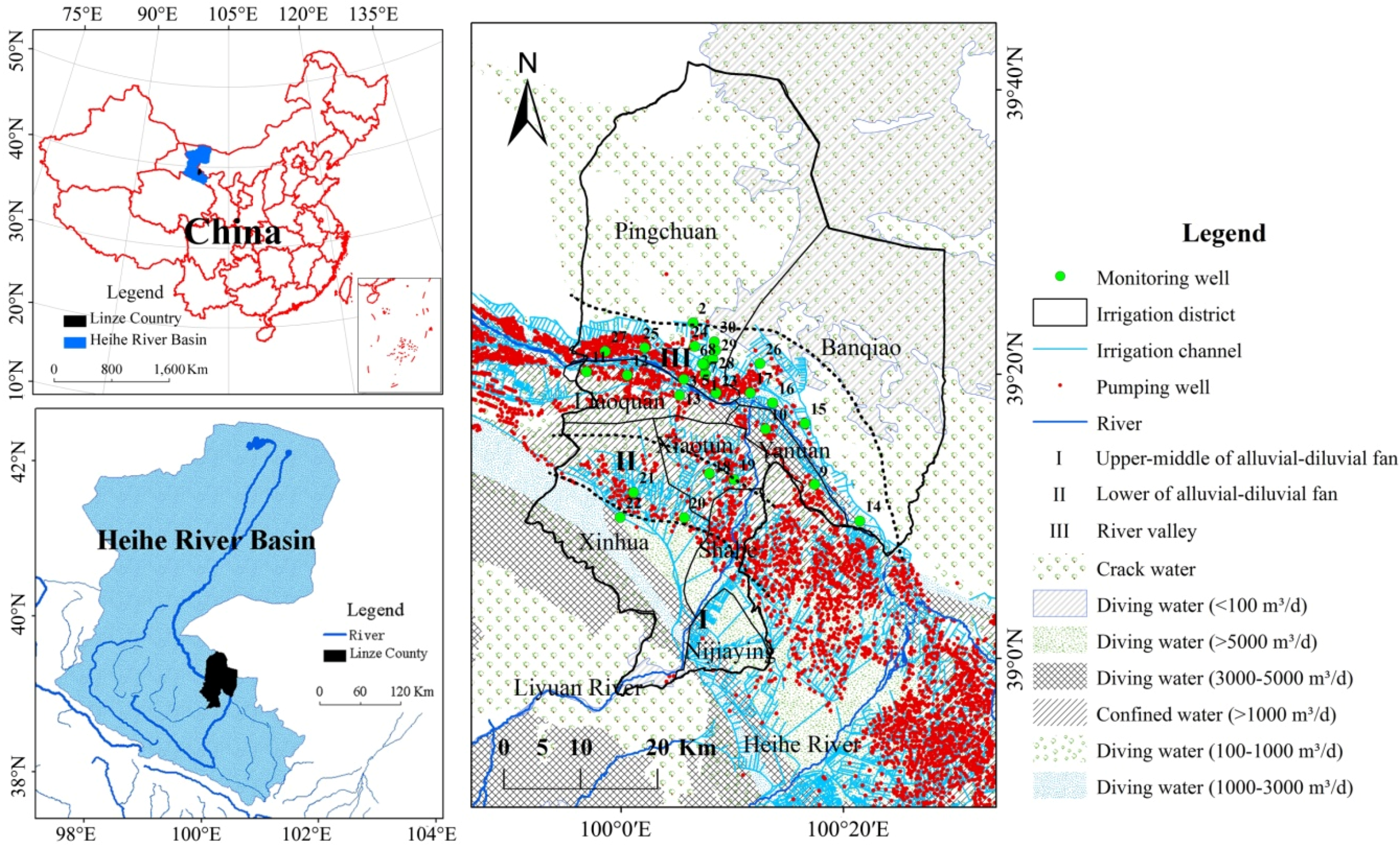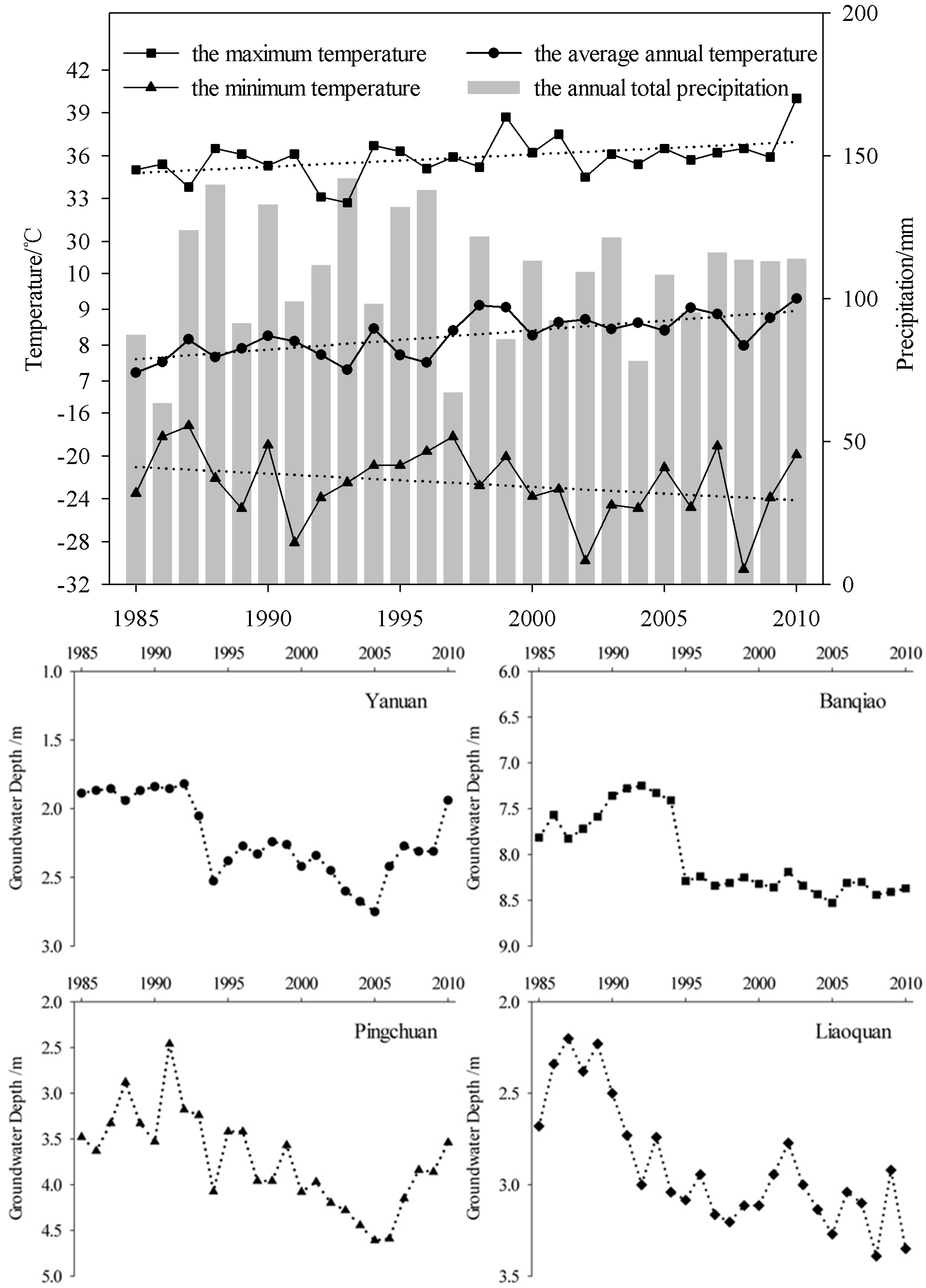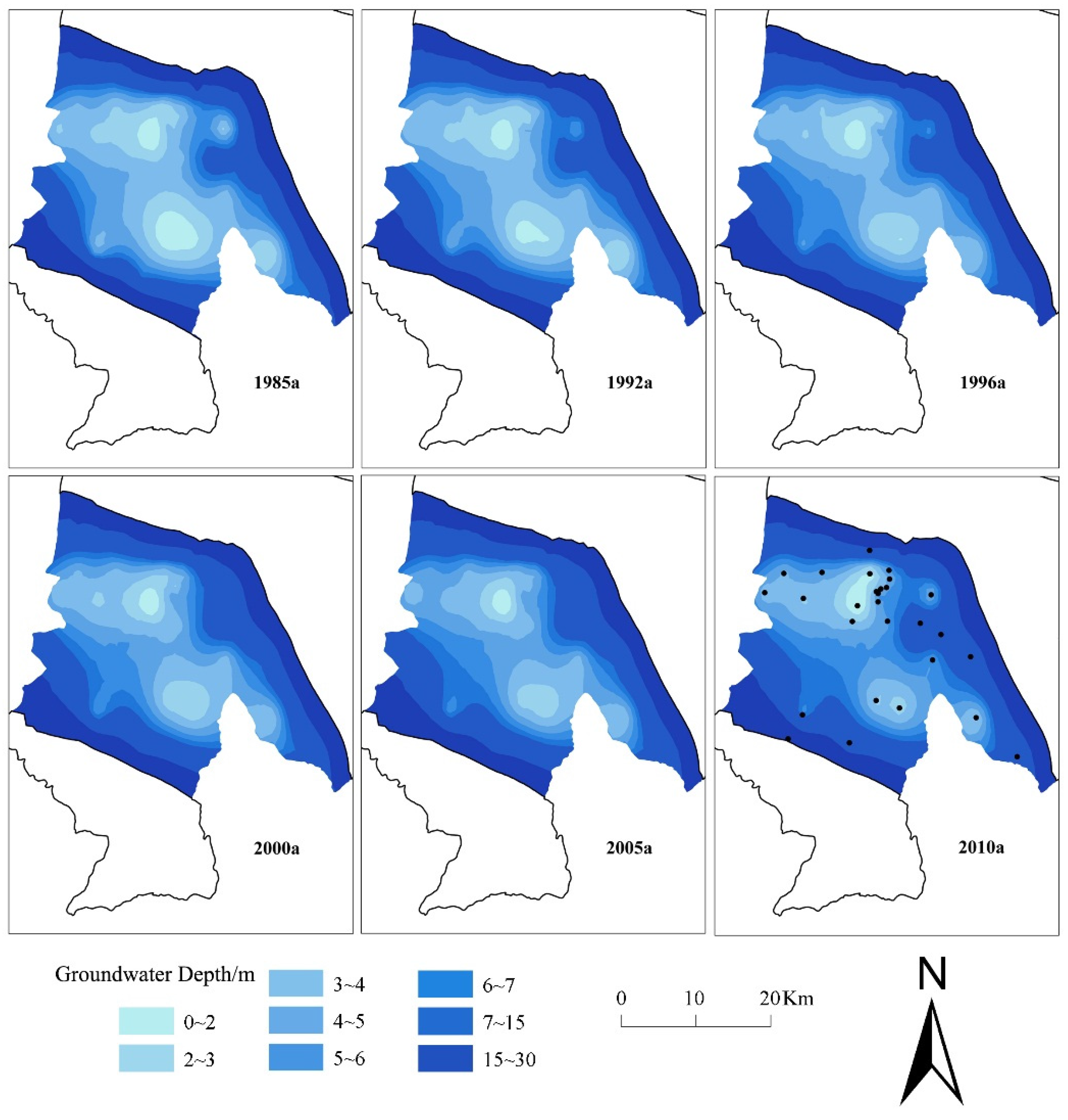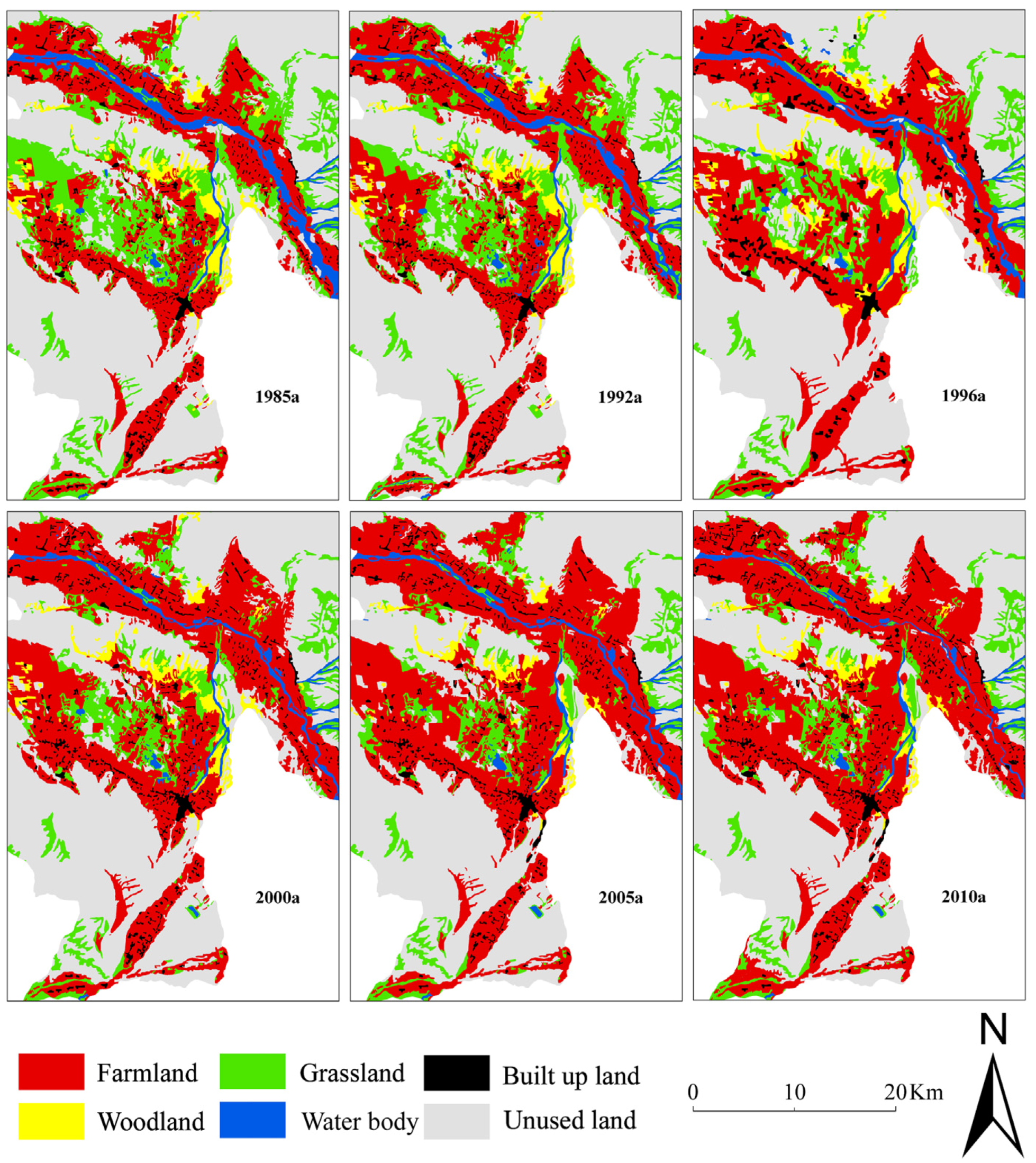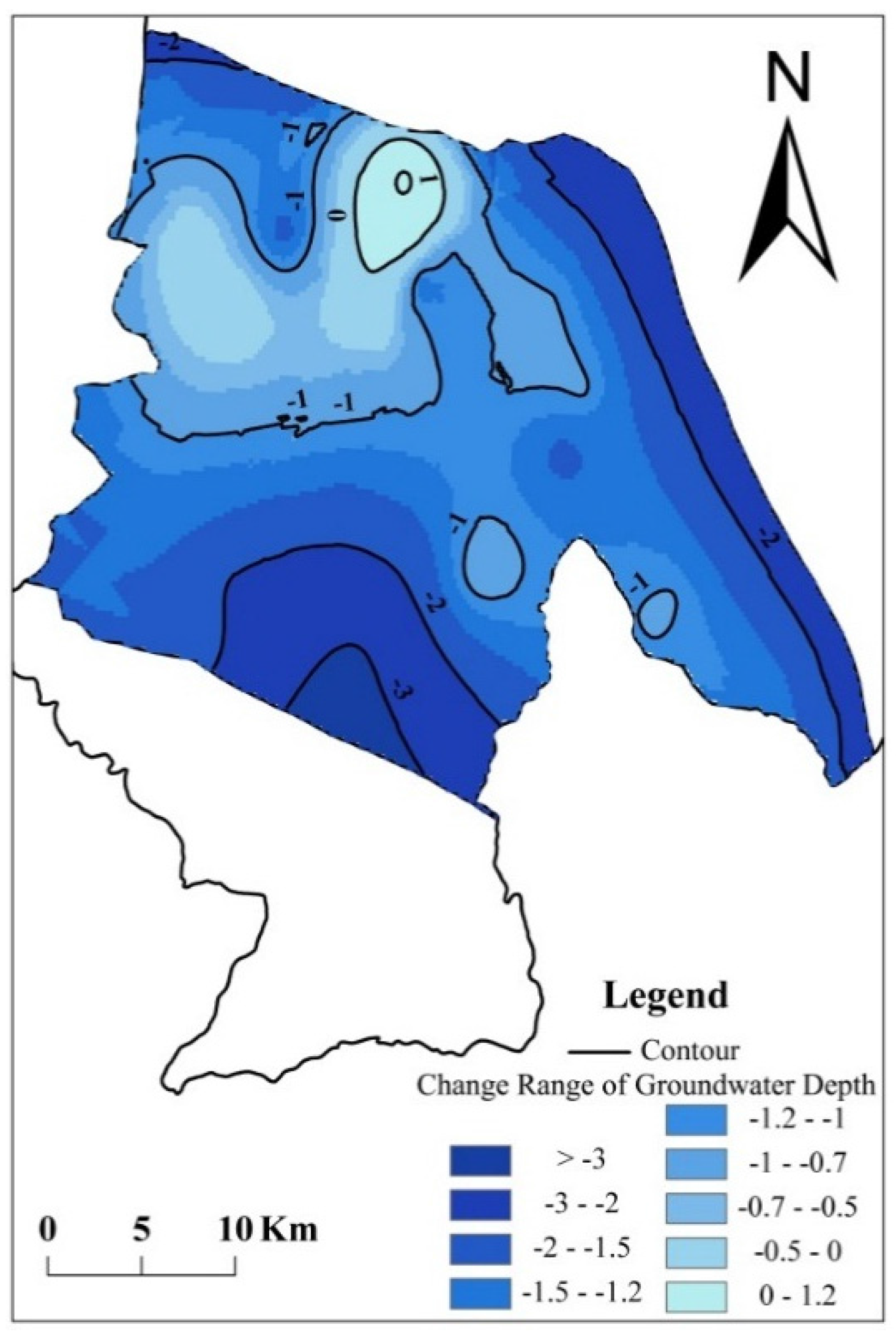2.1. Study Area
Linze County (38°57′–39°42′ N, 99°51′–100°30′ E), which geographically belongs to the middle reaches of the Heihe River basin, is located in the central part of Hexi Corridor (
Figure 1). The county covers an area of 2680 km
2. The altitude is between 1350 m and 2084 m above sea-level. The landscape is comprised of piedmont alluvial and diluvial gravel plain in the south and fine-grained soil plain in the central part. With the implementation of the Ecological Water Transfer Project (EWTP) of the Heihe River Basin from 2001, unified allocation of water resources is processed through the entire basin. The river water usage in the middle reaches has been considerably limited; as a result, the land use undergoes a noticeable change. With the expansion of the oasis agriculture in the middle reaches of Heihe River Basin, the irrigation area increased from 17.45 × 10
4 hm
2 in 1990 to 24.04 × 10
4 hm
2 in 2009. Based on the topographic units, the study area is divided into three hydro-geological units from south to north: the upper-middle part of the alluvial-diluvial fan in the south, the lower part of the alluvial-diluvial fan between the southern part and the central part, and the river valley plain in the middle. The aquifer is composed of single aquifer, multi-layer and confined aquifer [
26]. Groundwater mainly received the vertical infiltration recharge of river (flood, 0.6 × 10
8 m
3/a) and irrigation water (drainage system and cultivated land, 0.8 × 10
8 m
3/a), which accounted for approximately 80% of the total recharge (1.75 × 10
8 m
3/a); the infiltration recharge of lateral flow (0.3 × 10
8 m
3/a), precipitation and condensation water (0.05 × 10
8 m
3/a) accounted for approximately 20% [
27]. The water overflow of springs distributed in the Xiaotun irrigation district and the Pingchuan irrigation district, evaporation and artificial exploitation are the main drainage mechanisms of groundwater. The annual change of groundwater depth for four representative monitoring wells was showed in
Figure 2. The results presented that the groundwater depth in the study area decreased gradually.
Figure 1.
The study area and the distribution of observation wells in Linze County in the Heihe River basin, China.
Figure 1.
The study area and the distribution of observation wells in Linze County in the Heihe River basin, China.
Based on the data from the meteorological observation field in the Linze Inland River Basin Research Station, Chinese Academy of Sciences (CAS), the average annual temperature of the study area is 8.27 °C, and the maximum and minimum temperatures are 35.9 °C and −22.6 °C, respectively (
Figure 2). The annual total precipitation is 109 mm (
Figure 2) and is concentrated between July and September, which accounts for 65% of the annual total precipitation. The average annual potential evaporation is up to 2390 mm. The county is divided into eight irrigation districts, which are Pingchuan, Banqiao, Yanuan, Liaoquan, Xiaotun, Xinhua, Shahe and Nijiaying, respectively. The irrigation districts are mainly irrigated by the mainstream of Heihe River and its tributary, Liyuan River. The irrigation agriculture in the study area was highly developed. Crops planted here include wheat, seed maize, tomato, cotton, and greenhouse vegetables. There is a complete irrigation system with more than 300 main canals and branch canals. The number of pumping wells demonstrates a rapid increasing trend in the 1990s and 2000s (
Table 1).
Figure 2.
Change of annual total precipitation, annual temperature and annual groundwater depth between 1985 and 2010.
Figure 2.
Change of annual total precipitation, annual temperature and annual groundwater depth between 1985 and 2010.
Table 1.
The temporal series proportions of water resources between surface water irrigation and groundwater exploitation for each irrigation districts in three periods.
Table 1.
The temporal series proportions of water resources between surface water irrigation and groundwater exploitation for each irrigation districts in three periods.
| Irrigation District | Canal Irrigation (108 m3) | Groundwater (108 m3) | Well Number |
|---|
| 1985–1989 | 1990–1999 | 2000–2010 | 1985–1989 | 1990–1999 | 2000–2010 | 1985–1989 | 1990–1999 | 2000–2010 |
|---|
| Shahe | 0.20 | 0.44 | 0.27 | 0.03 | 0.10 | 0.23 | 12 | 53 | 129 |
| Yanuan | 0.30 | 0.63 | 0.44 | 0.006 | 0.018 | 0.088 | 8 | 16 | 79 |
| Liaoquan | 0.40 | 0.96 | 0.58 | 0.004 | 0.022 | 0.067 | 17 | 55 | 191 |
| Banqiao | 0.40 | 1.05 | 1.13 | 0.002 | 0.002 | 0.025 | 13 | 15 | 84 |
| Pingchuan | 0.60 | 1.05 | 0.72 | 0.018 | 0.075 | 0.177 | 50 | 144 | 337 |
2.2. Data
Groundwater data from 30 monitoring wells during 1985 and 2010 maintained by the Gansu Provincial Bureau of Hydrology and the Linze Inland River Basin Research Station, Chinese Academy of Sciences (CAS) were collected. The monitoring well distribution is shown in
Figure 1 and
Table 2. The depth of the groundwater table in January is determined on behalf of the annual groundwater depth because January is the month in which the groundwater table is relative the least impacted by irrigation. January measurements are the average of three time measurements, and the measurements are manually taken at 1, 11 and 21 per month by using tape. The irrigation data were collected from annual water resource management reports (1985–2010) published by the Zhangye Municipal Bureau of Water Conservancy. The meteorological data were obtained from the meteorological observation field in the Linze Inland River Basin Research Station, CAS.
Table 2.
The physical and hydro-geological conditions of the study area, together with the monitoring wells in different sub-areas [
28].
Table 2.
The physical and hydro-geological conditions of the study area, together with the monitoring wells in different sub-areas [28].
| Area Code | Subarea | Distribution and Natural Conditions | Hydro-Geological and Irrigation Conditions | Monitoring Well Code |
|---|
| I | Upper-middle of alluvial-diluvial fan | The River Valley alluvial plain, annual precipitation is 120–300 mm | Single unconfined aquifer, The groundwater depth is >30 m, river irrigation | 19–21 |
| II | Lower of alluvial-diluvial fan | The intersection zone of River Valley alluvial plain and fine-grained soil plain, annual precipitation is 0–255 mm | Transition from single aquifer to multi-layer and confined aquifer, The groundwater depth is during 5–30 m, mixed irrigation | 17, 18 |
| III | River valley | River Valley alluvial plain, annual precipitation is 60–130 mm | Multi-layer and confined aquifer, the groundwater depth is <10 m, mixed irrigation | 1–16, 22–30 |
The remote sensing data include five land use/cover classification maps (1985, 1996, 2000, 2005 and 2010) and Landsat_5 Thematic Mapper (TM) satellite image (Path/Row 164 and 38, 28 August 1992) under cloud-free conditions from the United States Geological Survey (USGS). The land use data in 1992 was clipped directly from the 1:100,000 scale land use database developed by the Chinese Academy of Sciences (CAS) [
29]. Preprocessing of the satellite image prior to image classification and change detection is essential and commonly comprises a series of sequential operations, including atmospheric correction or normalization, geometric correction, and image enhancement [
30]. The land use classification was conducted through visual interpretation to guarantee consistency and accuracy in the data processing. By field surveys and random sample checks, we confirmed that the overall interpretation accuracy of the land use classification was reliable. All maps and images were presented in the Universal Transverse Mercator (UTM) coordinate system referenced to the 1984 World Geodetic System (WGS84). According to the classification system of national land-use status [
31] and land-use characteristics in Linze County, landuse patterns in the study area have been divided into 6 types: farmland, woodland, grassland, water body, built up land and unused land.
2.3. Geostatistics
We analyzed the spatial distribution of the groundwater depth and the variability of the groundwater during the period between 1985 and 2010 in the study area using the geostatistics method based on the groundwater depths. Geostatistics is useful for capturing the spatial heterogeneity and spatial pattern of environmental variables.
Geostatistical theory is based on a stochastic model which allows the derivation of optimal predictions at random points in the considered region. It allows us to take into account spatial correlation between neighboring observations and includes different approaches spanning from conditional estimator to simulation, either parametric or indicator approach [
32]. It aims at providing quantitative descriptions of natural variables distributed in space and time [
33,
34]. Geostatistics can be used for the better management and conservation of water resources and sustainable development of any area [
20,
35], and geostatistical methods are good tools for water resources management and can effectively be used to derive the long term trends of the groundwater [
20]. Several studies used geostatistics for optimizing a groundwater monitoring network [
21,
36,
37,
38,
39]. Christakos performed the geostatistical analysis on water table elevation of about 70 wells in Kansas [
40]. Ahmadi and Sedghamiz applied geostatistics for spatial and temporal analyses of the groundwater levels in Darab plain of Iran [
22,
23]. Based on the above studies, geostatistical methods has been proved as an applicable and reliable tool to reveal stochastic structure of groundwater level variations in space and time, and for better management and conservation of water resources.
The semi-variance method and Kriging interpolation are basic methods of geostatistics [
34,
41]. Semi-variance is an autocorrelation statistic defined as:
where
r(h) is the semivariance for interval distance class
h;
Z(xi) is the measured sample value at point
xi;
Z(xi + h) is the measured sample value at point
xi + h; and
N(h) is the total number of sample couples for the lag interval
h.
Prior to the geostatistical estimation, we require a model that enables us to compute a variogram value for any possible sampling interval. The most commonly used models are spherical, exponential, Gaussian, and pure nugget effect [
34]. Assuming a normal distribution for the groundwater depth, a spatial interpolation model was created based on the regionalized variables
z(
xi) and
z(
xi +
h). The experimental variogram was fitted by an exponential model, that is:
where
r(h) is the semi-variance for interval distance class
h, and
h is the lag interval;
C0 is the nugget variance (
C0 ≥ 0);
C is the structural variance(
C ≥
C0); and
a is the range parameter. In the case of the exponential model, the effective range
A = 3
a, which is the distance at which the sill (
C +
C0) is within 5% of the asymptote (the sill never meets the asymptote in the exponential model).
The adequacy and validity of the developed variogram model was tested satisfactorily by a technique called cross-validation. This test allows us to assess the goodness of fitting (avoid sufficiency) of the variogram model (type, parameter estimates), the appropriateness of neighborhood and type of kriging used. Interpolated and observed values are compared, and the model that yields the most accurate predictions is retained [
34,
42]. The fitness of the semi-variogram model is evaluated using two parameters: the Residual Sum of Squares (
RSS) and coefficient of determination (
R2). RSS (
RSS > 0) provides an exact measure of how well the model fits the variogram data. The closer the value approaches 0, the better the model fits. The formula of
RSS is:
where
is the semi-variance calculated by the theoretical model.
R2 is the ratio between the regression sum of squares and the total sum of squares. The closer that the value approaches 1, the better the model fits. The formula of
R2 is:
where
is the average value of the semi-variance.
The GS+ software is then employed to measure geostatistical parameters. Spatial auto-correlation length (range), nugget variance and sill variance are derived from the fitted semi-variogram. The nugget variance (
C0) represents variance caused by random factors in small scale, the sill variance (
C0 +
C1) reflects the variation caused by structural factors in large scale, the ratio of them (
GD) can reflect the spatial correlation of groundwater depth. The ratio (
GD) can be used to classify the spatial dependence as strong if
GD is ≤25%, moderate if it is 25% ≤
GD ≤ 75%, and weak if it is ≥75%. This proportion of spatial structure determines the ratio in which random factors induce spatial variability [
43]. The degree of spatial dependence (
GD) was calculated as:
Kriging is one of the best local estimation methods. It can comprehensively consider the randomness and structure of variables, and estimate the spatial variation of the study object according to the distribution of sampling points and variogram models [
40]. Among the different kriging methods, we used ordinary for spatial and temporal analysis. The ordinary kriging method is mainly applied for datasets without and with a trend. Detailed discussions of kriging methods and their descriptions can be found in Goovaerts [
42]. The general equation for linear kriging estimation is:
To achieve unbiased estimations using ordinary kriging interpolation, the following set of equations should be solved simultaneously.
where
Z*(
χp) is the kriged value at location
χp,
Z(
χi) is the known value at location
χi,
λi is the weight associated with the data, μ is the Lagrange multiplier, and γ(
χi,χj) is the value of variogram corresponding to a vector with origin in
χi and extremity in
χj.
In this paper, the groundwater depth data in six different periods (1985, 1992, 1996, 2000, 2005 and 2010) were transformed into logarithms using the geostatistical analysis module of ArcGIS. Then the logarithms were interpolated using the fitted exponential model and ordinary kriging interpolation to obtain the spatio-temporal variability of groundwater depth in Linze County.
